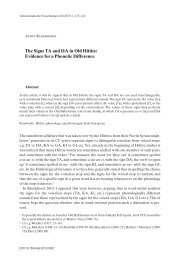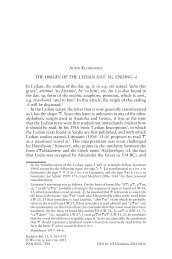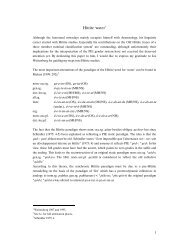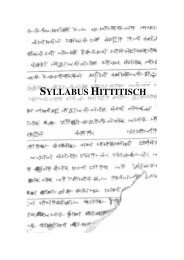Indo-European Nominal Ablaut Patterns - Alwin Kloekhorst ...
Indo-European Nominal Ablaut Patterns - Alwin Kloekhorst ...
Indo-European Nominal Ablaut Patterns - Alwin Kloekhorst ...
Create successful ePaper yourself
Turn your PDF publications into a flip-book with our unique Google optimized e-Paper software.
grade of the root syllable. 6 This means that ‘water’ should in fact go back to a proterodynamic<br />
paradigm *uód-r, *ud-én-. 7 Also the word for ‘knee’, which is usually reconstructed as a static u-stem<br />
*ǵón-u, *ǵén-u-, rather shows a proterodynamic inflection in Hittite: the stems genu- besides ganu- 8<br />
(instr. ganut) point to a paradigm *ǵén-u, *ǵn-éu-. 9 Since the only other alleged *o/e ablauting<br />
statically inflected noun, *nok w t-, *nek w t- ‘night’, 10 is not synchronically attested as such, I am<br />
sceptical as to whether this type really existed in PIE.<br />
For type 2, static nouns with an *ḗ/é ablaut, Schindler (1975a: 5-6) gives two main examples, which in<br />
my view both must be interpreted differently. The first example is the word for ‘liver’, which was<br />
reconstructed by Schindler as *i̯ ḗk w -r̥ , *i̯ ék w -n̥ -s (followed by e.g. Fortson 2004: 108 and Clackson<br />
2007: 94f.), but for which I rather reconstruct a proterodynamic paradigm, *iék w -r, *ik w -én-s. 11 The<br />
second example is Hittite mēḫur, mēḫunaš ‘time, period’, for which Schindler reconstructs *mḗh2-ur,<br />
*méh2-un-s, following Eichner 1973. Although I certainly believe that this latter word is static in the<br />
sense that it was root-accented throughout the paradigm, I have doubts regarding the reconstruction of<br />
the ablaut grades. As I have argued elsewhere, 12 I assume that mēḫur, mēḫun- should rather be<br />
reconstructed as *méih2-ur, *méih2-un-, i.e. a derivative of the root *meih2- (as attested in Skt. minā́ ti,<br />
Lat. minuō ‘to diminish’) with e-grade in both the nom.-acc. and the oblique stem. 13 An e-grade can<br />
also be found in the endingless loc.sg. form mēḫur < *méih2-ur. This ablaut pattern is supported by the<br />
6 This *u̯ dén- is the outcome of *udén- in which the *u̯ - of *u̯ ódr was secondarily introduced in order to<br />
eliminate the alternation between consonantal *u̯ - and vocalic *u-.<br />
7 In a paper presented at the 14th World Sanskrit Conference (Kyōto, September 2009), Lubotsky has shown that<br />
in Vedic, nom.-acc.sg. vā́ r ‘water’ < *uéh1r forms one paradigm with the stem ud(a)n- ‘id.’ < *ud-(e)n-.<br />
Lubotsky assumes that this situation is original, and that *uéh1r is in fact the phonetic outcome of an original<br />
form *uéd-r (showing a development *d > *h1 as also known in *h1ḱmtom < *dḱmtom ‘100’, *h1uih1ḱmti <<br />
*duidḱmti ‘20’). If so, we must assume that ‘water’ originally inflected *uéd-r, *ud-én-, which already within<br />
PIE yielded *uéh1r, *udén-. Since CLuwian u̯ ār(ša) ‘water’ attests to nom.-acc.sg. *uéh1r, this paradigm must<br />
have been present as such in Proto-Anatolian as well. Only in pre-Hittite, *uéh1r apparently was replaced by<br />
*uódr, although the exact origin of this latter form is unclear to me (perhaps it was taken from compounds?).<br />
8 Note that ganu- cannot reflect *ǵónu-, since this would have yielded Hitt. **gānu-.<br />
9 Supported by Av. žnubiias ‘knees (dat.-loc.pl.)’ and Germ. *kniu- ‘knee’.<br />
10 It is true that for ‘night’ an o-grade stem is attested in Lat. nox, Gr. νύξ, Germ. *naχt-, Lith. naktìs, OCS noštь,<br />
whereas Hitt. nekuz (gen.sg.) shows an e-grade, but this does not necessarily mean that we must reconstruct an<br />
*o/e ablauting static paradigm. Moreover, in his fthc. Etymological Dictionary of Proto-Germanic, my colleague<br />
Guus Kroonen (p.c.) will propose to connect the word for ‘night’ with the root *d h ng w - as attested in the<br />
Germanic words for ‘dark’ (OHG tunkal, OSax. dunkar) and in Hitt. dankui- ‘dark’. His idea is that the root<br />
originally was *d h neg w -, in which the cluster *d h nV- was simplified to *nV- in PIE already. We could therefore<br />
imagine that when in e.g. an original hysterodynamic paradigm *d h nég w -t, *d h ng w -ét-m, *d h ng w -t-és (for which<br />
see section 5) the nom.sg. form regularly developed into *nég w -t, the whole paradigm was reshaped. We may<br />
have to assume that on the one hand, the stem *nég w -t was used as a basis for a static paradigm (*nég w -t,<br />
*nég w -t-m, *nég w -t-s), or that the root *neg w - was generalized throughout the paradigm, yielding *nég w -t,<br />
*nog w -ét-m, *nog w -t-és (with regular change of unaccented *e > *o as described in section 8). The former<br />
paradigm could have yielded the Hitt. gen.sg. form nekuz, whereas the latter could have been the basis for<br />
*nok w t- as attested in the other IE languages.<br />
11 The reconstruction of a lengthened grade stem *iēk w - is based on two forms. For the first form, Av. yākarǝ, De<br />
Vaan (2003: 68-9) has shown that this hapax is less trustworthy than its duplicate yakarǝ, which rather points to<br />
a short vowel in the root syllable (with which it would be parallel to the other Iranian languages that all point to a<br />
PIr. form *i̯ akar). The second form, Gr. ἧπαρ is not trustworthy either. Already Szemerényi (1956: 191) argued<br />
that, since in Greek several words for organs contain an -η- (ἧτορ ‘heart’, κῆρ ‘heart’, σπλήν ‘spleen’), the -η- in<br />
ἧπαρ might be secondary. This would mean that there is no reliable evidence for reconstructing a lengthened<br />
grade stem *iēk w - anymore. A stem *iek w - is well attested, however: Skt. yákr̥ t, Lat. iecur, Lith. jẽknos ‘liver’.<br />
Moreover, evidence for a stem *ik w - can be found as well: Lith. ìkras ‘roe, spawn, caviar’, Latv. ikri ‘id.’, and<br />
Slav. *jьkrà ‘id.’ go back to a stem *ik w -r-. The existence of a stem *iek w - beside *ik w - rather points to a<br />
proterodynamic paradigm, which is supported by the full grade in the suffix syllable of the Lat. gen.sg. form<br />
iocineris (cf. footnote 33 for the exact origin of this latter form). Hence the reconstruction *iék w -r, *ik w -én-s.<br />
12 See <strong>Kloekhorst</strong> 2008: 567-8.<br />
13 The idea that the ‘strong’ stem should always contain an ablaut grade that is one grade ‘heavier’ than the<br />
‘weak’ stem (*ē besides *e, or *o besides *e) is a theoretical preconception.<br />
2






